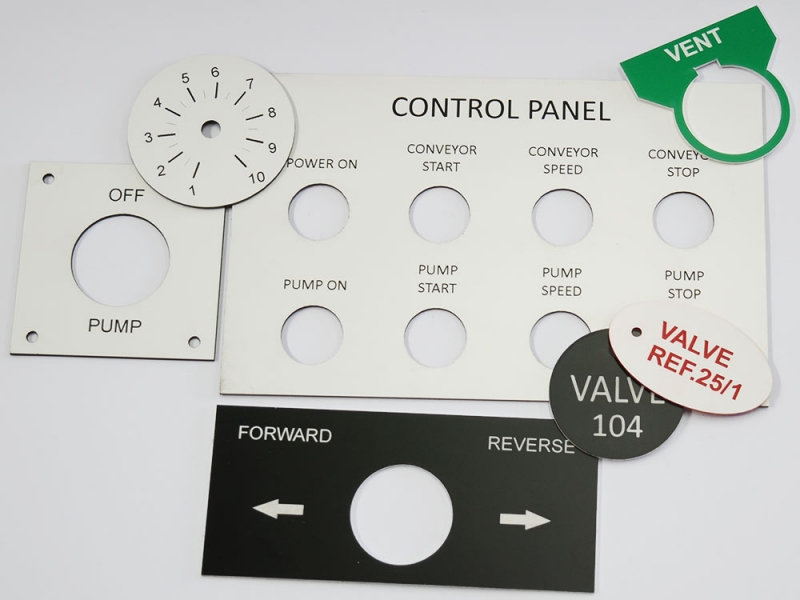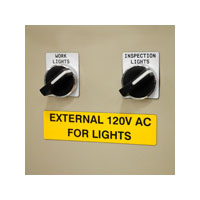

Mechanical equipment labeling also should include type and location of control. Equipment labeling may include voltage, source-panel name, and source-panel location (if elsewhere in the facility). Lockout-tagout procedures should be considered when deciding labeling details. Any panel or piece of equipment should have a label to identify where power can be disconnected (see Figure 2). Labels for panel/circuit information are not limited to receptacles. Engraved cover plates are an option when environmental conditions can cause failure of label adhesives. Additionally, the type of material used for the label should be suitable for the environment, as noted in 2017 NEC Article 110.21(B)(3). Details of receptacle cover-plate labels are specified by the design engineer and should be coordinated with the naming configuration and label type desired by the facility. The receptacle faceplate color is required to identify a connection to an emergency branch per NFPA 99-2015: Health Care Facilities Code, Article 6.4.2.2.6.2(C).

A common application for informational signage is to identify the panel name and circuit number on a receptacle faceplate as required by NEC 2017 Article 517.19. Informational labels may be code-required, at the request of the facility, or as specified by the designer for enhanced understanding.

While the safety labels are intended to identify hazards, informational labels assist facilities in understanding how the equipment is connected and provide instructions for proper operation. The second reason for labeling is informational. Designers should specify lighting levels sufficient for identifying hazards and reading signage. These are important aspects for designers and facility personnel to apply. An unfavorable reading condition may be caused by poor lighting or poor viewing angles. If the message is describing a hazardous condition, it should be legible from outside the hazardous area. The guidelines for font sizing are directly related to the distance at which the message is to be considered legible.

Table 1 references ANSI Z535.4-2011 and illustrates recommended font sizes based on viewing distance.
#Electrical control panel labels software#
Commercial software is available for development of signage that complies with OSHA, ANSI, and ISO regulations. OSHA references ANSI for color codes and adds the definition of a biohazard.Īdditional signage guidelines in ANSI Z535.4-2011 include text justification and text arrangement, order of information, grammar, text font and size, letter spacing and line spacing, and multilingual arrangement. 145-2013, Specifications for accident prevention signs and tags, includes specifications for signs and tags to prevent accidents and directs the facility to inform personnel about the intent of color codes and verbiage. Red is specified for fire protection equipment, danger, or “stop.” Yellow is specified for caution and marking physical hazards associated with falling or tripping.
#Electrical control panel labels code#
144-2007, Safety color code for marking physical hazards, defines safety color codes for marking hazards. This flow chart can help the designer or facility personnel to determine which signal word to choose and the color codes assigned to each hazard condition. The flow chart depicted in Figure 1 is derived from ANSI Z535.4-2011, Figure E2. ANSI distinguishes the meaning behind several common words and when it is appropriate to use them.Īn example of a required “DANGER” label is in 2017 NFPA 70, Section 110.34(C), which requires rooms containing equipment with a nominal voltage greater than 1,000 V to include a sign at the entrance labeled “DANGER-HIGH VOLTAGE-KEEP OUT.” The details of this signage can be referenced in ANSI. Engineers should ensure that the labeling requirements listed in the design specifications are not in conflict with those specified by the ANSI standard. ANSI Z535.4-2011: Product Safety Signs and Labels is referenced in NEC Article 110.21 and provides specific guidelines for signage. These requirements apply to field-applied markings and signage. Additional labeling requirements are listed in 2017 NEC Article 110.21. Both of these sections address the first reason to provide descriptive equipment labels: for personnel safety. These requirements are echoed in NFPA 70-2017: National Electrical Code (NEC), Article 110.16. This section specifies the type of labeling information required and includes available incident energy and personal protective equipment (PPE) categories. An obvious location to look for requirements is NFPA 70E-2015: Standard for Electrical Safety in the Workplace, Article 130.5(C)(2)(D). Strategies for labeling and documentation are partially driven by applicable code requirements.


 0 kommentar(er)
0 kommentar(er)
